
For the next four weeks, I’ll be writing about team themes and the evolution of character designs. I started design work on the JLA set in October of 2004. Just me at home, mostly on the weekends in between hands of online poker. I had just finalized the team selections, so it was time to get started on the rosters and team themes.
Being the premiere team of DC Comics, I was quite excited to tackle the JLA. With the long history of the team and even longer history of some of the members, there was a lot of information to draw from. Since the team is so iconic, and most of the core members are household names, my earliest idea of a direction for the team reflected this public status. I mean, these characters have faced so many perils and seen every trick in the book, so we know their powers and abilities inside and out.
The design direction I wanted to explore for the JLA team was based around all of their tricks being on the board. The team is so well known that they just aren’t going to spring any surprises on you. They’ll beat you fair and square using their tried-and-true tactics; they’ll overcome all obstacles because you know what they are capable of. About the only time you see something new out of the team is when a new member joins up. I didn’t want to give the team any tricky plot twists that would surprise their opponents. I wanted their tricks to come mainly from characters on the board.
The first theme I wanted for the team was a way for its members to benefit each other through their close proximity. Sound familiar? Mike and I had been independently thinking about what eventually became the leader keyword. Once Avengers fleshed out leader, I decided to find another way for characters to help each other. This theme evolved into ally, which is like leader in many cases, but with a much different condition to fulfill.
The second theme I wanted for the team was some sort of plot twist disruption. With Wonder Woman and her magic lasso as the starting point, this theme took quite some time to flesh out.
Lastly, I wanted to carry over the willpower theme started in Green Lantern Corps. There are several Lanterns, magic types, and holy persons on the team, so it seemed a natural fit. Willpower doesn’t just have to apply to someone who can create constructs.
The ally keyword came into being in mid-April 2005. I already had several characters receiving bonuses when they became powered-up, but there were almost no alternate ways to get powered-up. Ben Seck suggested allowing the natural pairs within the JLA to power-up each other. See his preview of the card Heroes Welcome for more on the topic. I liked the idea but didn’t want to limit it to just this “buddy system” style. I wanted everyone on the team to have alternate means of becoming powered-up, and I wanted them to get some plot twist–like benefit for doing so. This changed the focus of my “all tricks are on the board” theme from adjacency to power-ups. Shortly thereafter, the ally powers were often triggering when anyone on the team became powered-up. That was the real breakthrough. From there, the team started to shape up quite nicely. But back to the characters.
While deciding on the team members, it’s nearly impossible to avoid writing down a few first impression powers for the characters. Just thinking about some heroes demands that you try to convert their powers into Vs. System terms. I refined my original ideas for four months before turning over the first design file to development on March 8, 2005. The other R&D members have never seen my earliest designs. Below are some of the JLA character cards as they were at various stages of design and development. When you see a <p> in the text, that tells our pre-press department (the people who build the cards) to insert a paragraph break so the cards aren’t one continuous line of text.
Key
Original: November 2004. By the middle of this month, I had given each character in the set a “first pass” power. These were heavily thematic powers that helped me to see where team themes might present themselves.
Turnover: March 8, 2005. This was the day I turned over my design file to the developers.
Development: April 19, 2005—a week after ally became what you see today. Sometimes, the development team made changes. Other times, they came to me and asked for a rewrite.
Final: This is the text you see on the card today.
Snapper Carr
Original
He started out and finished as a 1-cost, 1 ATK / 1 DEF character. His original text was, “JLA defenders adjacent to Snapper Carr have reinforcement.”
Mike was deep in Avengers design and development at this time, and he started calling adjacency powers “leader,” so Snapper had to go back the drawing board.
Turnover
“Pay 1 resource point >>> JLA characters you control have reinforcement while defending this turn. <p> Activate >>> Power-up target equipped attacker or defender you control.”
Snapper is a gadgeteer, so I wanted him to work well around equipment. I had given some of the JLA characters power-up triggers when they became powered-up, so I wanted to make it that much easier. However, the development team didn’t want to do resource point powers again so soon after Masters of Evil.
Development
“Activate >>> Target JLA defender you control has reinforcement this attack. <p> Activate >>> Power-up target equipped attacker or defender you control.”
He was close to his final form, but it needed to be easier to get maximum usage out of him.
Final
Snapper Carr, Cool Daddy-O
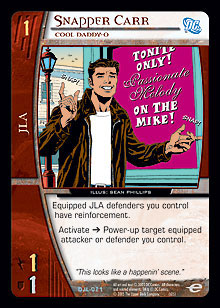 “Equipped JLA defenders you control have reinforcement. <p> Activate >>> Power-up target equipped attacker or defender you control.”
“Equipped JLA defenders you control have reinforcement. <p> Activate >>> Power-up target equipped attacker or defender you control.”
If you’re going to make an equipment deck, you might as well get your money’s worth.
Elongated Man
Original
He started out as a 3-cost, 4 ATK / 4 DEF character. His original text was, “Elongated Man is considered to be adjacent to all JLA characters you control in the visible area.”
He’s a stretchy guy, so he can be everywhere at once. I changed his power when Mike ran with the adjacent theme, and I figured this might be a headache anyway.
Turnover
Now a 2-cost, 3 ATK / 2 DEF.
“At the start of the combat phase, you may look at target face-down resource. <p> Whenever Elongated Man becomes powered-up, you may replace target face-down resource.”
This was part of the plot twist denial theme for the team. It turned out to be very strong, completely wrecking opposing resource rows. This was an early foray into the power-up triggers, but the ally keyword was still a month away.
Development and Final
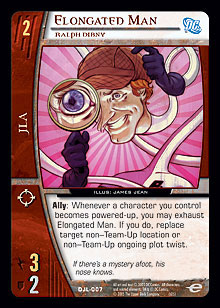 “Ally: Whenever a character you control becomes powered-up, you may exhaust Elongated Man. If you do, replace target non–Team-Up location or non–Team-Up ongoing plot twist.”
“Ally: Whenever a character you control becomes powered-up, you may exhaust Elongated Man. If you do, replace target non–Team-Up location or non–Team-Up ongoing plot twist.”
Once ally came into the picture, his previous power was easily converted to something much more fair.
Faith
Original
She started out as a 3-cost, 4 ATK / 4 DEF.
“JLA characters adjacent to Faith get +1 DEF. <p> Boost 1: When Faith comes into play, at the start of the combat phase, characters adjacent to Faith get +1 ATK / +1 DEF this turn.”
She has an aura that makes people feel good, but I knew I needed to get away from the adjacency theme (except for leader characters).
Turnover
Now a 2-cost, 2 ATK / 2 DEF.
“Willpower 1 <p> Activate >>> JLA defenders you control get +X DEF this turn, where X is Faith’s willpower. <p> Boost 1: When Faith comes into play, she gets +1 willpower and +3 ATK this turn.”
This version was way too scary, as increasing willpower with the rings and such could make her a defensive beast for the whole team.
Development
“Willpower 3 <p> Activate >>> Target JLA character with willpower 1 or greater you control gets +2 DEF this attack.”
We tried to fix her by removing the boost and making her defensive mod help just one character, but it still ended up too good.
Final
Faith, “The Fat Lady”
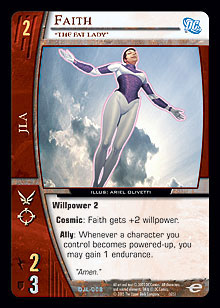 “Willpower 2 <p> Cosmic: Faith gets +2 willpower. <p> Ally: Whenever a character you control becomes powered-up, you may gain 1 endurance.”
“Willpower 2 <p> Cosmic: Faith gets +2 willpower. <p> Ally: Whenever a character you control becomes powered-up, you may gain 1 endurance.”
She’s now part of the cosmic mini-theme of the JLA, she’s an ally, and she has willpower to spare. I wanted to make her cosmic to show that she has access to a lot of power when she’s forced to use it.
Aquaman
Original
He started out as a 2-cost, 3 ATK / 2 DEF.
“Whenever an opponent reveals a card he has searched for out of his deck, search that player’s deck for all other copies of that card and remove them from the game. That player then shuffles his deck.”
I was getting a bit tired of watching people use search cards every turn of the game, so I wanted to make a “search hoser” that somewhat played into the plot twist disruption theme—as in, people wouldn’t use searchers while he was around. This power was way too narrow and dumb.
Turnover
Now a 3-cost, 4 ATK / 5 DEF.
“Willpower 3 <p> Leader: Remove three target cards in a KO’d pile from the game >>> Power-up an adjacent character with cost less than or equal to Aquaman’s willpower. Use this power only once per attack.”
I toyed with power-ups and removing cards from the KO’d pile, but this turned out to be quite clunky and rarely usable on turn 3.
Development
Now a 3-cost, 5 ATK / 4 DEF.
“Willpower 2 <p> Aquaman gets +1 ATK / +2 DEF while your opponents have no cards in their KO’d piles. <p> Ally: Whenever a character you control would become powered-up, instead, you may remove up to two target cards in any KO’d pile from the game.”
Replacing the power-up was rarely the right answer, but when it was, it was too good, so . . .
Final
Aquaman, Arthur Curry
 “Willpower 2 <p> Aquaman gets +1 ATK / +2 DEF while each of your opponents has no cards in his KO’d pile. <p> Ally: Whenever a character you control becomes powered-up, you may remove target card in a KO’d pile from the game.”
“Willpower 2 <p> Aquaman gets +1 ATK / +2 DEF while each of your opponents has no cards in his KO’d pile. <p> Ally: Whenever a character you control becomes powered-up, you may remove target card in a KO’d pile from the game.”
Removing just one card from an opponent’s KO pile is still good, but you can’t wipe the Secret Society’s entire KO’d pile with a single New Teen Titans anymore.
Plastic Man
Original
He started out as a 3-cost character with no printed stats.
“Plastic Man’s ATK is equal to the number in the 1s column of your endurance. <p> Plastic Man’s DEF is equal to the number in the 10s column of your endurance.”
Originally, his ATK was better than his DEF, and his stats changed every time your endurance changed. I didn’t want him to be Overloaded at the drop of a hat, so if he didn’t have any printed stats, he couldn’t be.
Turnover
“Plastic Man’s ATK is the number in the 10s column of your endurance. <p> Plastic Man’s DEF is the number in the 1s column of your endurance.”
I decided before turning over the file that being as hard to hurt as he is, he should have better DEF than ATK. Plus, it’s so much easier to figure out his stats when they read exactly like your endurance does.
Development
Now a 3-cost, 0 ATK / 0 DEF.
“At the start of the combat phase, Plastic Man’s printed ATK becomes the 10s digit of your endurance, and his printed DEF becomes the 1s digit of your endurance.”
Development didn’t like the idea of his stats changing all the time, as figuring out the order to make attacks became crazier than the card’s extended art foil version.
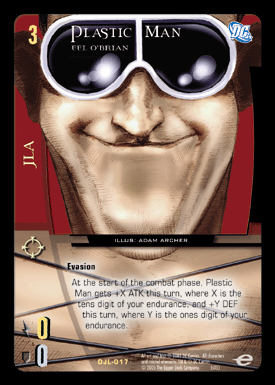 Final
Final
Plastic Man, Eel O’Brian
“Evasion <p> At the start of the combat phase, Plastic Man gets +X ATK this turn, where X is the tens digit of your endurance, and +Y DEF this turn, where Y is the ones digit of your endurance.”
Evasion was a late addition to the card, but it allowed you to manipulate your own endurance to make his stats to your liking.
This was actually the first character in the JLA set to be designed. One day in early 2004, Danny Mandel and I were thinking about crazy characters, as we were trying to make Mike’s head explode. It sorta worked.
Wonder Woman
Original
She started out as a 3-cost, 5 ATK / 5 DEF.
“Cosmic: Opponents play with their hands revealed. <p> Boost 1: When Wonder Woman comes into play, your opponents cannot play plot twists from their resource rows, and Wonder Woman gets +2 ATK / +2 DEF this turn.”
My first concept of the “truth” was for your opponent’s secrets to be revealed, and I was toying with the plot twist disruption theme.
Turnover
Now a 4-cost, 7 ATK / 7 DEF.
“Willpower 3 <p> Leader: Adjacent JLA characters with cost less than or equal to Wonder Woman’s willpower can’t be targeted by effects your opponents control. <p> Boost 1: When Wonder Woman comes into play, put two +1 ATK / +1 DEF counters on her.”
I had expanded the definition of willpower by this point and wanted to support it. Unfortunately, I had gotten away from the lasso concept I had liked earlier.
Development
“Willpower 2 <p> At the start of each opponent’s attack step, that opponent names a plot twist. He cannot play plot twists with another name this attack step. <p> Boost 1: When Wonder Woman comes into play, put two +1 ATK / +1 DEF counters on her.”
The development team liked my original concept better, so we tested this for a while.
Final
Wonder Woman, Avatar of Truth
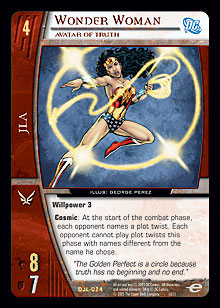 “Willpower 3 <p> Cosmic: At the start of the combat phase, each opponent names a plot twist. Each opponent cannot play plot twists this phase with names different from the name he chose.”
“Willpower 3 <p> Cosmic: At the start of the combat phase, each opponent names a plot twist. Each opponent cannot play plot twists this phase with names different from the name he chose.”
She proved to be so good that her power became cosmic, and boost had to go for balance reasons as well.
Firestorm
Original
He started out as a 4-cost, 7 ATK / 7 DEF.
“Whenever Firestorm powers-up, JLA characters adjacent to him get +1 ATK / +1 DEF this turn.”
This was the only card in my original design that referenced power-ups helping others, so it might have been partially responsible for the creation of the ally keyword.
Turnover
Now a 5-cost, 9 ATK / 9 DEF.
“When Firestorm comes into play, remove a cosmic counter from him unless you discard a JLA character card. <p> Cosmic: Firestorm gets +3 ATK / +1 DEF.”
For some reason, I went away from the power-up theme and gave him an ability that simulated the fact that he’s a merged being. He was proving to be very good, so he had to be changed completely.
Development
“Ally: Whenever a character you control becomes powered-up, you may put a cosmic counter on target character with cosmic you control. <p> Cosmic: Whenever Firestorm attacks, power-up Firestorm.”
Oh, you recognize this card? Indeed, we gave it to Zatanna, Zatanna Zatara in May for thematic reasons.
Final
Firestorm, The Nuclear Man
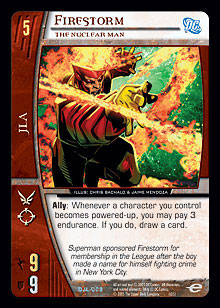 “Ally: Whenever a character you control becomes powered-up, you may pay 3 endurance. If you do, draw a card.”
“Ally: Whenever a character you control becomes powered-up, you may pay 3 endurance. If you do, draw a card.”
This power had been on Zatanna, so they just swapped powers. Thematically, I liked the idea of his merged consciousness providing extra brainpower and therefore extra cards.
Batman
Original
He started out as a 6-cost, 14 ATK / 14 DEF.
“Concealed—Optional <p> Batman gets -1 ATK / -1 DEF for each other character you control. <p> Boost 1: Whenever a JLA character you control becomes stunned this turn, you may return that character to its owner’s hand.”
I wanted to make a loner version of Batman who didn’t like hanging around with the JLA do-gooders. At this time, I had a 2-drop Batman on the team who was a total team player.
Turnover
Now a 6-cost, 12 ATK / 13 DEF.
“Whenever Batman becomes powered-up, you may negate target non-ongoing plot twist effect. <p> Leader: Pay 1 endurance >>> Whenever target adjacent character would become stunned this turn, you may return it to owner’s hand instead.”
Here I am toying with the power-up triggers again, and I still have the “return characters to hand” power on him for no good reason. As an “instead,” it meant no stun, which was a bit too good.
Development
Now a 6-cost, 13 ATK / 12 DEF.
“Ally: Whenever a character you control would become powered-up, instead, you may discard a JLA character card. If you do, negate target non-ongoing plot twist effect.”
As an “instead,” this ally power replaced the power-up, and that was a bit too anti-social for the main ally team. Note that his power required a JLA character discard to work. We overlooked the fact that it would make him worthless in the Gotham Knights team.
Final
Batman, Avatar of Justice
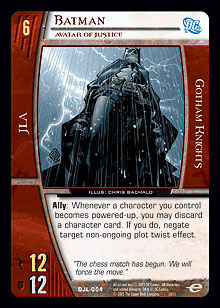 “Ally: Whenever a character you control becomes powered-up, you may discard a character card. If you do, negate target non-ongoing plot twist effect.”
“Ally: Whenever a character you control becomes powered-up, you may discard a character card. If you do, negate target non-ongoing plot twist effect.”
Now he’s not team-stamped, so anyone can use his anti–plot twist power.
Superman
Original
He started out as a 7-cost, 15 ATK / 15 DEF.
“Whenever Superman would stun a character, return it to owner’s hand instead. <p> While Superman is ready, JLA characters adjacent to him can’t be attacked.”
His attacks could only cause breakthrough, and on defense, his leader power screamed, “Attack me!” But I figured that invulnerability might be a better way to go.
Turnover
Now a 7-cost, 16 ATK / 14 DEF.
“While a character named Superman you control is powered-up, whenever he stuns a character, return that character to owner’s hand. <p> Leader: Adjacent JLA defenders have invulnerability.”
Now I’d incorporated the power-up theme, and his leader power said, “Attack me first.” A variation on his power-up ability eventually ended up on Lex Luthor, Evil Incorporated. How fitting. This sort of leader power never seems to work, unfortunately.
Development
“Ally: Whenever a character you control becomes powered-up, target character protected by Superman gains invulnerability this turn. <p> Leader: Adjacent characters have flight, and while attacking, get +2 ATK.”
This version focused the invulnerability, but how and when the character became invulnerable was still a bit unfocused. Also, the bonus +2 ATK on the leader power was too much.
Final
Superman, Avatar of Peace
Now a 7-cost, 17 ATK / 16 DEF.
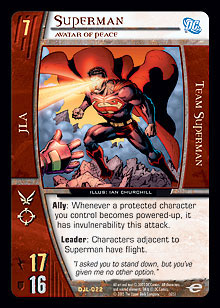 “Ally: Whenever a protected character you control becomes powered-up, it has invulnerability this attack. <p> Leader: Characters adjacent to Superman have flight.”
“Ally: Whenever a protected character you control becomes powered-up, it has invulnerability this attack. <p> Leader: Characters adjacent to Superman have flight.”
The invulnerability is now streamlined and his stats went up a bit. As I’ve said before, “Nice, huh?”
Some of the above cards went through many more iterations than what I’ve presented, but this should give you a general idea of how cards change and how they become a coherent part of a team. Sometimes the changes are very small, some are complete rewrites, and some cards change so frequently that files had to be time stamped instead of just date stamped. Design and development is a time-consuming process, but it’s always fun and a challenge.
Well, that is the longest article I’ve written on Metagame.com to date. I was going to include some support cards for the team, but I’d bore some of you to death. If you’d like me to include a special “Part 5” of this series, send me an email with a request to do a non-character “Evolution” article. If you have a favorite non-character card in the JLA set and you’d like to see how it came to be, let me know that, too.
Send questions or comments to mhyra@metagame.com.